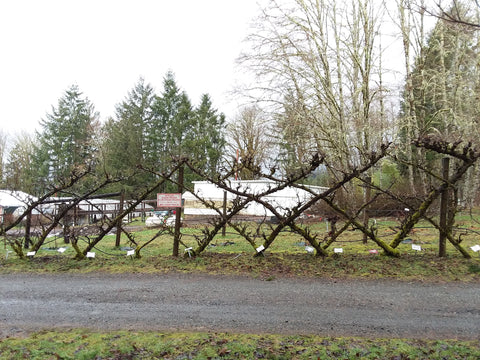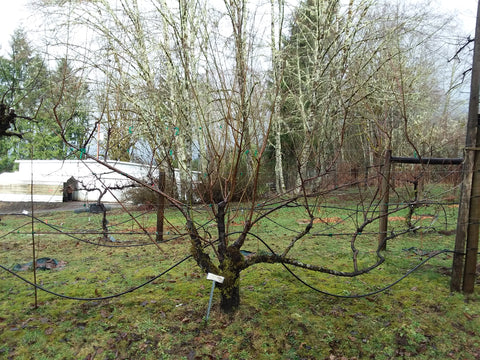
Espalier and Other Intensive Pruning and Training
By Xander Rose
Imagine relaxing in a courtyard at a villa on the outskirts of Paris. A market garden stretches out beyond the house, supplying fresh produce for sale at a local market down the road. The courtyard faces south and the warm sunlight is heating the stone walls and cobblestone ground. An apple tree seems like a sculpture, like living art, its trunk tightly growing up the sheltered south wall and its branches spreading horizontally outward like arms. A peach tree with a short trunk has branches that grow like a fan spayed on the wall next to the apple, wooden stakes guiding its many growing points. Imagine picking a sweet ripe peach while leaning back in a lawn chair. The market garden beyond the courtyard has rows of more espalier apples as well as stone fruits like the peach trained into cordons in various styles. This is a high density orchard setting. Espalier and its variants allow getting more fruit from a small space with more control. Espalier for apples and pears, V or fan-shaped and other training systems for stone fruits make sense in a setting like the one described. The time and investment of the diligent pruning and trellis building required can be justified where the climate is relatively dry and real estate has high value. The two-dimensionality of espalier can maximize light capture and fruit production in a small space. In this blogpost I’ll introduce these intensive pruning and training systems as applied to fruit trees. In a another post, I look at training fruiting vines through the lenses of what I’ve learned so far in my home orchard and from working at Raintree.

An unusual espalier apple tree at Raintree, trained into a candelabra shape.
The reader with a small yard can get more fruit from less space by training trees in dense structural arrangements. Pollination could be improved by the close proximity of the trees’ flowers. It will take more inputs (irrigation water, mulch, compost, fertilizer, time, and materials) to grow trees in a more artificial way than it would if they are allowed to grow more naturally as erect, free-standing trees. Cleverly using trees’ growth habits in intensive training can be a rewarding project though.
Briefly, consider how hormones govern trees. Cytokinins made in the roots move up the tree to break dormancy at the tips of the highest branches. Auxin goes down the tree from apical (topmost or outermost) buds creating apical dominance by suppressing lateral buds. Apical dominance leads to trees to grow tall. Controlling the apex or leader of the tree by pruning and training (such as by tying to a stake or wire) is key to creating espalier. Selected dwarfing rootstocks can help keep the size of the tree small. Rootstocks should be investigated in consideration of desired tree size and soil type. Seasonality of pruning influences the tree’s growth; in general, summer pruning will suppress growth and dormant season (winter) pruning will encourage more growth. Espalier apples and pears should generally be pruned in the summertime.
Trees can be purchased that are already on their way to being trained as espalier, but any young apple or pear can be trained. The idea is to train horizontal side branches opposite each other. A branch scaffold trained at acute to horizontal angles relative to the vertical trunk can be termed a cordon. The node where a branch joins the trunk is strongest closest to 90 degrees (a horizontal branch parallel to the ground). The first level of cordons is started two or three feet above the ground. Branches can be guided to close to horizontal by tying them to trellis wires. There can be as many levels of branches as desired, but three or four levels each about a foot above the last form a pedestrian tree within reach from the ground or a foot ladder. At planting a one year-old whip (sapling fruit tree) can be topped about a third down from the top. This will stimulate side branching and two appropriate side branches opposite each other can be trained to be the first two cordons. Fruit spurs will grow from these and can be rejuvenated through pruning. A new, weaker top will have sprouted in the second year as well and can be topped slightly or allowed to grow straight up (with training to the trellis) depending on how tall it grew. More cordon levels can be added through selection, training, and pruning.

Steeply angled cordons at Raintree
Stone fruit don’t work as well as apples and pears in espalier. Stone fruit are species in the genus Prunus like plums (Asian and European), apricots, peaches, nectarines, and cherries. Peach and nectarines bear fruit on second year wood, so being able to rejuvenate old wood for fruit production in the training is important. Cherries and plums bear fruit on long-lived fruit spurs. Blind wood is old wood lacking buds that will not produce new wood for rejuvenating the tree. Some stone fruits, such as especially cherries, will grow too tall if left to their own devices (not trained or pruned), which can result in the fruit being too high up on the tree (for the birds).

A peach tree trained into a fan shape at Raintree
Stone fruit can be planted at a 45 degree angle to the ground onto a six foot trellis of three or four taught wires spaced equidistant from each other vertically (the trellis constructed variously, but possibly using fence posts and in-line wire tighteners). Trees grown this way can be considered single cordon. Lateral branches arising from the cordon can be trained to the trellis and fruiting wood renewed through heading cuts. Stone fruits are generally best pruned in spring and summer. A variation on this simple cordon is a V shapes., with two cordons going in opposite directions on the trellis at 45 degrees to the ground. Apples can be trained this way as well. I already mentioned the fan. There are many specialized and variously complex training systems to explore for the intensive orchard. WSU Tree Fruit lists some of them here (including seven systems just for cherries!): http://treefruit.wsu.edu/orchard-management/pruning-and-training-systems/.
Thanks for reading and happy fruit tree training and pruning! We may not all get to live in a villa in France, but we can still dream of fruit-filled yards and maybe even materialize through years of diligent effort an espalier apple on that vacant hot south wall...
Happy growing! Because, after all, change is the only constant. -Xander Rose
References:
Chicago Botanic Garden. 2021. “Espalier an Apple Tree.” <https://www.chicagobotanic.org/plantinfo/espalier_apple_tree>. Accessed Feb. 13 2021.
Deppe, Carol. 2010. The Resilient Gardener: Food Production and Self-Reliance in Uncertain Times. Vermont: Chelsea Green Publishing Company.
Gilkeson, Linda. 2011. Backyard Bounty: The Complete Guide to Year-Round Organic Gardening in the Pacific Northwest. BC, Canada: New Society Publishers.
Johnson, Kristan. 2011. “Well-bred Fruit for the Maritime Climate.” Pacific Horticulture Society. <pacifichorticulture.org/articles/well-bred-fruit-for-the-maritime-climate-2/>. Accessed Feb. 13 2021.
Strawbridge, D. and James Strawbridge. 2010. Self-Sufficiency for the 21st Century. Great Britain: Dorling Kindersley Limited.
WSU Tree Fruit. 2021 “Pruning and Training Systems.” <http://treefruit.wsu.edu/web-article/apple-pruning-training/>. Accessed Feb. 13 2021.

